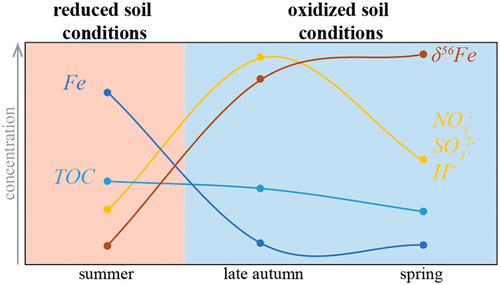当前位置:
X-MOL 学术
›
ACS Earth Space Chem.
›
论文详情
Our official English website, www.x-mol.net, welcomes your
feedback! (Note: you will need to create a separate account there.)
Seasonal Variations of Redox State in Hemiboreal Soils Indicated by Changes of δ56Fe, Sulfate, and Nitrate in Headwater Streams
ACS Earth and Space Chemistry ( IF 2.9 ) Pub Date : 2019-12-06 , DOI: 10.1021/acsearthspacechem.9b00237 Sarah Conrad 1 , Stefan Löfgren 2 , Susanne Bauer 1, 3 , Johan Ingri 1
ACS Earth and Space Chemistry ( IF 2.9 ) Pub Date : 2019-12-06 , DOI: 10.1021/acsearthspacechem.9b00237 Sarah Conrad 1 , Stefan Löfgren 2 , Susanne Bauer 1, 3 , Johan Ingri 1
Affiliation

|
During recent decades, much focus has been put on the iron (Fe) isotope ratios in soils, rivers, and oceans, while studies on the variation in headwater streams are scarce. Here we assess seasonal water chemical data from 104 hemiboreal headwater streams. Between summer and late autumn, decreasing Fe concentrations and simultaneously increasing sulfate and nitrate concentrations suggest a shift from reduced to oxidized conditions in the soils along the main groundwater flow paths. Fe isotope data, obtained from a subpopulation of 16 streams, show low δ56Fe ratios during summer drought, indicating an important influx of reduced groundwater to the streams with primarily Fe(II) as an important Fe source. In total, the δ56Fe data ranged between −0.8 ± 0.1 and 1.8 ± 0.1‰ with the lowest values in summer and maximum δ56Fe ratios in late autumn or spring, indicating an influx of more oxidized, less Fe(II) rich groundwater during those seasons. Local differences in δ56Fe ratios between the headwater streams, seemed to be driven by the different soil redox status of the catchments. The streams with the lowest δ56Fe ratios during summer are characterized by a small share (4.4 ± 6.6%) of wetlands, indicating discharge of reduced groundwater from mainly anoxic, moist, organic-rich mineral soils during drought. Relatively high total organic carbon (TOC) concentrations (2.4 ± 1.1 mM) and low pH (5.2 ± 0.8) may have restricted efficient Fe(II) oxidation in streamwater especially during the late autumn survey. Our results from hemiboreal headwater streams reveal the importance of climatic, pedogenic, and land cover-derived controls on the provenance of stream Fe loads that is likely broadly applicable to similar streams elsewhere.
中文翻译:

在Hemiboreal土壤的变化δ指示的氧化还原状态的季节变化56铁,硫酸盐和硝酸盐的水源流
在最近的几十年中,人们非常关注土壤,河流和海洋中铁(Fe)的同位素比率,而关于源头水流变化的研究却很少。在这里,我们评估了来自104个半波源水源流的季节性水化学数据。在夏季和深秋之间,铁的浓度降低,同时硫酸盐和硝酸盐的浓度增加,表明土壤沿主要地下水流动路径从还原状态转变为氧化状态。从16个流的子群中获得的Fe同位素数据显示,夏季干旱期间δ56 Fe比率低,这表明大量还原的地下水主要以Fe(II)作为重要的Fe源流入到这些流中。总体上,δ 56铁数据介于-0.8和之间±0.1 1.8±0.1‰在夏季和最大值δ最低值56个那些季节期间在晚秋或弹簧的Fe比率,指示更氧化的涌入,以下的Fe(II)富地下水。在δ局部差异56点的水源流之间的Fe比,似乎是由集水区的不同土壤的氧化还原状态被驱动。具有最低δ流56夏季的铁比率以湿地的一小部分(4.4±6.6%)为特征,表明干旱期间主要是缺氧的,潮湿的,富含有机物的矿物土壤中的地下水减少了。较高的总有机碳(TOC)浓度(2.4±1.1 mM)和较低的pH(5.2±0.8)可能会限制流水中有效的Fe(II)氧化,尤其是在深秋调查期间。我们从半水源河源溪流中获得的结果表明,气候,土壤成因和土地覆盖来源的控制对于溪流铁负荷来源的控制很重要,这很可能广泛适用于其他地方的类似溪流。
更新日期:2019-12-07
中文翻译:

在Hemiboreal土壤的变化δ指示的氧化还原状态的季节变化56铁,硫酸盐和硝酸盐的水源流
在最近的几十年中,人们非常关注土壤,河流和海洋中铁(Fe)的同位素比率,而关于源头水流变化的研究却很少。在这里,我们评估了来自104个半波源水源流的季节性水化学数据。在夏季和深秋之间,铁的浓度降低,同时硫酸盐和硝酸盐的浓度增加,表明土壤沿主要地下水流动路径从还原状态转变为氧化状态。从16个流的子群中获得的Fe同位素数据显示,夏季干旱期间δ56 Fe比率低,这表明大量还原的地下水主要以Fe(II)作为重要的Fe源流入到这些流中。总体上,δ 56铁数据介于-0.8和之间±0.1 1.8±0.1‰在夏季和最大值δ最低值56个那些季节期间在晚秋或弹簧的Fe比率,指示更氧化的涌入,以下的Fe(II)富地下水。在δ局部差异56点的水源流之间的Fe比,似乎是由集水区的不同土壤的氧化还原状态被驱动。具有最低δ流56夏季的铁比率以湿地的一小部分(4.4±6.6%)为特征,表明干旱期间主要是缺氧的,潮湿的,富含有机物的矿物土壤中的地下水减少了。较高的总有机碳(TOC)浓度(2.4±1.1 mM)和较低的pH(5.2±0.8)可能会限制流水中有效的Fe(II)氧化,尤其是在深秋调查期间。我们从半水源河源溪流中获得的结果表明,气候,土壤成因和土地覆盖来源的控制对于溪流铁负荷来源的控制很重要,这很可能广泛适用于其他地方的类似溪流。











































 京公网安备 11010802027423号
京公网安备 11010802027423号